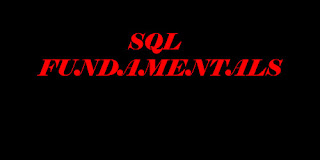The
SQL was initially called SEQUEL (Structured English Query Language).
The acronym SEQUEL was later changed to SQL because "SEQUEL"
Relational Database
– The
Relational Database uses relations or two dimensional tables to store
information.
ER Modeling – An entity
relationship (ER) model is an illustration of various entites in a business and
the relationships among them.
Entity – A thing of
significance about which information needs to be known. Examples are students,
departments, employees.
Attribute/Column – Something that
describes or qualifies an entity. For example employee entity has emp no, name,
job title, hire date, etc. attributes.
Relationship – A named
association between entities showing optionality and degree.
Field – A field is the
smallest unit in a table.
Record/Row/Tuple – A record is
nothing more than a collection of fields or columns horizontally.
Database Objects
Schema – Collection of
objects is called Schema. For example table, view, index, sequence.
Table – Logical
structures of rows and columns. Or/ Basic storage structures of an RDBMS.
Or/
A table holds a collection of records. A table can have upto 1000 columns and
‘n’ number of rows.
Views – Virtual table which
does not contain any data that refers to the base-table.
Index – Pointer for faster
retrieval of data.
Sequence – It is a unique
sequential number generated by database objects.
Synonyms – Alternative name of
the database.
Constraints
Rules
which are enforce on the data when we are inserting data in database.
Not Null(C)- It should not be blank in the columns.
Unique(U)- It should not be
repeated value.
Primary Key(P)- It is a
combination of not null & unique. And should not be blank & repeated
values.
Foreign Key(R)- It is use to
define to relates table, we should enter a valid data except null.
Check(C) – It is condition
if condition is satisfied we can insert data into database.
SQL Statements
Data Manipulation
Language(DML) – It
retrieves data from the database, enters new rows, changes existing rows, and
removes unwanted rows from tables in the database. It consists of SELECT,
INSERT, UPDATE, DELETE, MERGE.
Data Definition
Language(DDL) – It
sets up, changes and removes data structures from tables. It consists of
CREATE, ALTER, DROP, RENAME, TRUNCATE, COMMENT.
Data Control
Language(DCL) – It
gives of removes access rights to both the Oracle Database and the structures
within it. It consists of GRANT and REVOKE.
Transaction Control
Language(TCL) – It
manages the changes made by the DML statements. Changes to the data can be
grouped together into logical transactions. It consists COMMIT, ROLLBACK,
SAVEPOINT.
Data Manipulation
Language(DML)
Data
Manipulation Language(DML) is a core part of SQL. When you want to add, update,
or delete data in the database, you execute a DML statement. A collection of
DML statements that form a logical unit of work is called a transaction.
Capabilities of SQL
Select Statement
The
select statement retrieves information from the database.
Capabilities of SQL
Select Statement
#
Selection- Choose the rows in a
table that are returned by a query. Various criteria can be used to restrict
the rows that are retrieved.
#
Projection- Choose the columns in a
table that are returned by a query. Choose as few or as many of the columns as
needed.
#
Join- Bring together data that is
stored in different tables by specifying the link between them. SQL joins are
used to display data from multiple tables.
Select Statement
Format:
##
Select * |{[DISTICT] column | expression [alias],….}
FROM
table;
Where
DISTICT- All retrieved records are of different values.
Null Values
If
a row lacks a data value for a particular column, that value is said to be null
or to contain a null. A null is a value that is unavailable, unassigned,
unknown, or inapplicable. A null is not the same as a zero or a space. Aero is
a number and a space is a character.
Column Alias
An
alias renames a column heading. It immediately follow the column names follow
by AS.
Insert Statements
It
is used to add new rows to a table by using the INSERT statement.
Syntax:
INSERT INTO TABLE ([column, ……,.., n] VALUES [value,….., n]);
Update Statements
It
is used to modify the existing rows in a table.
Syntax:
UPDATE
TABLE
SET
COLUMN = VALUE
WHERE
CONDITION;
Delete Statements
It
is used to remove existing rows from a table.
Syntax:
DELETE TABLE;
Row deletion from a
table
#
Specific rows are deleted if you specify the WHERE clause as
Syntax:
DELETE
FROM TABLE
WHERE
CONDITION;
It
deletes all the rows satisfying the CONDITION.
#
All rows in the table are deleted if you omit the WHERE clause as
Syntax:
DELETE
FROM TABLE;
It
deletes all the rows from the table.
Truncate Statement
It
is a data definition language(DDL) statement. It removes all rows from a table,
leaving the table empty and the table structure intact.
Syntax:
TRUNCATE TABLE

No comments:
Post a Comment